Ultrafast Laser-Enabled 3D Glass Microchannel Reactors
Abstract
1. Introduction
2. Fabrication of Glass Microchannel Reactors Using Ultrafast Laser
3. Applications of Ultrafast Laser-Enabled Glass Microchannel Reactors
3.1. Continuous-Flow Solid–Liquid Reactions
3.2. Continuous-Flow Gas–Liquid Reactions
3.3. On-Chip Continuous-Flow Synthesis with Real-Time Spectral Monitoring
3.4. Automated Remote Synthesis
3.5. Ultraviolet Photochemical Continuous-Flow Synthesis
3.6. Synthesis of Ultrasmall Semiconductor Polymer Nanomaterials
4. Summary and Outlook
Funding
Conflicts of Interest
References
- Deng, J.; Zhang, J.S.; Wang, K.; Luo, G.S. Microreaction technology for synthetic chemistry. Chin. J. Chem. 2019, 37, 161–170. [Google Scholar] [CrossRef]
- Zhang, J.W.; Zhou, Y.W.; Chen, Z.; Xu, J.H. Advances in frontiers of organic synthesis in microreactor. CIESC J. 2022, 73, 3472–3482. [Google Scholar]
- Feng, S.H.; Kang, K.; Salaudeen, S.; Ahmadi, A.; He, Q.S.; Hu, Y.L. Recent advances in algae-derived biofuels and bioactive compounds. Ind. Eng. Chem. Res. 2022, 61, 1232–1249. [Google Scholar] [CrossRef]
- Elvira, K.S.; Solvas, X.C.I.; Wootton, R.C.R.; de Mello, A.J. The past, present and potential for microfluidic reactor technology in chemical synthesis. Nat. Chem. 2013, 5, 905–915. [Google Scholar] [CrossRef] [PubMed]
- Munirathinam, R.; Huskens, J.; Verboom, W. Supported catalysis in continuous-flow microreactors. Adv. Synth. Catal. 2015, 357, 1093–1123. [Google Scholar] [CrossRef]
- Bogdan, A.R.; Dombrowski, A.W. Emerging trends in flow chemistry and applications to the pharmaceutical industry. J. Med. Chem. 2019, 62, 6422–6468. [Google Scholar] [CrossRef]
- Xu, Y.; Zhang, D.Y.; Meng, X.Y.; Liu, X.; Sheng, S.; Wu, G.H.; Wang, J.; Wu, F.A. Generic DART-MS platform for monitoring the on-demand continuous-flow production of pharmaceuticals: Advancing the quantitative protocol for caffeates in microfluidic biocatalysis. J. Pharm. Biomed. Anal. 2017, 137, 243–251. [Google Scholar] [CrossRef]
- Cichowski, D.; Zhang, P.C.; Woias, P.; Krossing, I.; Cobry, K. Laser rapid-prototyping and modular packaging of chip-based microreactors for direct fluorination reactions. Chem. Eng. Res. Des. 2017, 128, 318–330. [Google Scholar] [CrossRef]
- Marre, S.; Jensen, K.F. Synthesis of micro and nanostructures in microfluidic systems. Chem. Soc. Rev. 2010, 39, 1183–1202. [Google Scholar] [CrossRef]
- Wang, W.; He, X.H.; Zhang, M.J.; Tang, M.J.; Xie, R.; Ju, X.J.; Liu, Z.; Chu, L.Y. Controllable Microfluidic Fabrication of Microstructured Materials from Nonspherical Particles to Helices. Macromol. Rapid Commun. 2017, 38, 1700429. [Google Scholar] [CrossRef]
- He, Y.H.; Liu, Q.J.; Lv, Y.C. Study on reaction characteristics of solution polymerization system for butyl rubber preparation in microreactor. CIESC J. 2021, 72, 1001–1008. (In Chinese) [Google Scholar]
- Tan, Z.; Zheng, Y.; Shi, H.; Xu, W.; Jia, X.; Dan, Z.; Liao, J.; Dai, Z.; Xu, C. Research progress and application exploration of typical microreactor technologies for health monitoring and disease diagnosis/treatment. Chem. Eng. J. 2024, 499, 155938. [Google Scholar] [CrossRef]
- Chen, Y.C.; Wang, Y.B.; Yan, Z.F.; Deng, J.; Luo, G.S. Selective removal of H2S over CO2 in a membrane gas-liquid microdispersion microreactor. Sep. Purif. Technol. 2023, 314, 123600. [Google Scholar] [CrossRef]
- Qi, Y.B.; Zeng, J.L.; Wang, K.K. Microfluidic solvent extraction of phenol from wastewater containing phenolic compounds in a circle capillary microreactor. Can. J. Chem. Eng. 2025, 103, 2826–2836. [Google Scholar] [CrossRef]
- Wang, Y.P.; Jin, Y.; Wang, Y.F.; Li, J.; Huang, M.G.; Chen, M. Extraction of Cu2+ from wastewater in a novel spiral microchannel. Chem. Eng. Process. Process Intensif. 2022, 181, 109128. [Google Scholar] [CrossRef]
- Aghel, B.; Biabani, A. Using solar microreactors and photocatalysts to synthesize biodiesel. Renew. Energy 2024, 220, 119654. [Google Scholar] [CrossRef]
- Lu, W.Q.; Zhang, R.J.; Toan, S.; Xu, R.; Zhou, F.Y.; Sun, Z.; Sun, Z.Q. Microchannel structure design for hydrogen supply from methanol steam reforming. Chem. Eng. J. 2022, 429, 132286. [Google Scholar] [CrossRef]
- Gopi, R.; Dineshkumar, M.; Anand, R. Biodiesel production using microreactor with integrated microheater through multi-objective optimization approach. Chem. Eng. Process. Process Intensif. 2024, 195, 109646. [Google Scholar]
- Liu, Y.; Jiang, X.Y. Why microfluidics? Merits and trends in chemical synthesis. Lab Chip 2017, 17, 3960–3978. [Google Scholar] [CrossRef]
- Balti, M.; Efrit, M.L.; Leadbeater, N.E. Preparation of vinyl ethers using a Wittig approach, and their subsequent hydrogenation employing continuous-flow processing. Tetrahedron Lett. 2016, 57, 1804–1806. [Google Scholar] [CrossRef]
- Gutmann, B.; Cantillo, D.; Kappe, C.O. Continuous-flow technology–A tool for the safe manufacturing of active pharmaceutical ingredients. Angew. Chem. Int. Ed. 2015, 54, 6688–6728. [Google Scholar] [CrossRef]
- Britton, J.; Jamison, T.F. A unified continuous flow assembly-line synthesis of highly substituted pyrazoles and pyrazolines. Angew. Chem. Int. Ed. 2017, 56, 8823–8827. [Google Scholar] [CrossRef] [PubMed]
- Baumann, M.; Moody, T.S.; Smyth, M.; Wharry, S. A perspective on continuous flow chemistry in the pharmaceutical industry. Org. Process Res. Dev. 2020, 24, 1802–1813. [Google Scholar] [CrossRef]
- Pelleter, J.; Renaud, F. Facile, fast and safe process development of nitration and bromination reactions using continuous flow reactors. Org. Process Res. Dev. 2009, 13, 698–705. [Google Scholar] [CrossRef]
- Hartman, R.L.; McMullen, J.P.; Jensen, K.F. Deciding whether to go with the flow: Evaluating the merits of flow reactors for synthesis. Angew. Chem. Int. Ed. 2011, 50, 7502–7519. [Google Scholar] [CrossRef]
- Zheng, J.; Niu, Y.; Song, Z.; Li, N.; Ju, S.H. Application Of 3D Printing Technology In Microreactor Fabrication. JOM 2025, 77, 415–430. [Google Scholar] [CrossRef]
- Watts, P.; Haswell, S.J. The application of micro reactors for organic synthesis. Chem. Soc. Rev. 2005, 34, 235–246. [Google Scholar] [CrossRef]
- Zhang, J.S.; Wang, K.; Teixeira, A.R.; Jensen, K.F.; Luo, G.S. Design and scaling up of microchemical systems: A review. Annu. Rev. Chem. Biomol. Eng. 2017, 8, 1–23. [Google Scholar] [CrossRef]
- Haswell, S.J.; O′Sullivan, B.; Styring, P. Kumada–Corriu reactions in a pressure-driven microflow reactor. Lab Chip 2001, 1, 164–166. [Google Scholar] [CrossRef]
- Kockmann, N.; Gottsponer, M.; Roberge, D.M. Scale-up concept of single-channel microreactors from process development to industrial production. Chem. Eng. J. 2011, 167, 718–726. [Google Scholar] [CrossRef]
- Chen, C.; Hirdes, D.; Folch, A. Gray-scale photolithography using microfluidic photomasks. Proc. Natl. Acad. Sci. USA 2003, 100, 1499–1504. [Google Scholar] [CrossRef]
- Queste, S.; Salut, R.; Clatot, S.; Rauch, J.Y.; Khan Malek, C.G. Manufacture of microfluidic glass chips by deep plasma etching, femtosecond laser ablation, and anodic bonding. Microsyst. Technol. 2010, 16, 1485–1493. [Google Scholar] [CrossRef]
- Dodge, A.; Fluri, K.; Verpoorte, E.; de Rooij, N.F. Electrokinetically driven microfluidic chips with surface-modified chambers for heterogeneous immunoassays. Anal. Chem. 2001, 73, 3400–3409. [Google Scholar] [CrossRef]
- Zhao, X.M.; Xia, Y.N.; Whitesides, G.M. Soft lithographic methods for nano-fabrication. J. Mater. Chem. 1997, 7, 1069–1074. [Google Scholar] [CrossRef]
- Qi, S.Z.; Liu, X.Z.; Ford, S.; Barrows, J.; Thomas, G.; Kelly, K.; McCandless, A.; Lian, K.; Goettert, J.; Soper, S.A. Microfluidic devices fabricated in poly(methyl methacrylate) using hot-embossing with integrated sampling capillary and fiber optics for fluorescence detection. Lab Chip 2002, 2, 88–95. [Google Scholar] [CrossRef] [PubMed]
- Greener, J.; Li, W.; Ren, J.; Voicu, D.; Pakharenko, V.; Tang, T.; Kumacheva, E. Rapid, cost-efficient fabrication of microfluidic reactors in thermoplastic polymers by combining photolithography and hot embossing. Lab Chip 2010, 10, 522–524. [Google Scholar] [CrossRef] [PubMed]
- Wang, X.; Liedert, C.; Liedert, R.; Papautsky, L. A disposable, roll-to-roll hot-embossed inertial microfluidic device for size-based sorting of microbeads and cells. Lab Chip 2016, 16, 1821–1830. [Google Scholar] [CrossRef] [PubMed]
- Utko, P.; Persson, F.; Kristensen, A.; Larsen, N.B. Injection molded nanofluidic chips: Fabrication method and functional tests using single-molecule DNA experiments. Lab Chip 2011, 11, 303–308. [Google Scholar] [CrossRef]
- Dong, Z.; Wen, Z.; Zhao, F.; Kuhn, S.; Noel, T. Scale-up of micro- and milli-reactors: An overview of strategies, design principles and applications. Chem. Eng. Sci. X 2021, 10, 100097. [Google Scholar] [CrossRef]
- Zhao, S.; Wang, H.; Hu, X.; Liu, Y.; Fang, Z.; Su, Y.; Guo, K.; Zhu, N. Macro-microreactor-based process intensification for achievement of high-mixing-performance, low-pressure-drop, and high-throughput liquid–liquid homogeneous chemical processes. Ind. Eng. Chem. Res. 2025, 64, 797–810. [Google Scholar] [CrossRef]
- Peng, T.; Lin, X.; Yuan, S.; Zhou, M.; Jiang, B.; Jia, Y. Mixing enhancement in a straight microchannel with ultrasonically activated attached bubbles. Int. J. Heat Mass Transfer. 2023, 217, 124635. [Google Scholar] [CrossRef]
- Chen, H.; Meiners, J.C. Topologic mixing on a microfluidic chip. Appl. Phys. Lett. 2004, 84, 2193–2195. [Google Scholar] [CrossRef]
- Therriault, D.; White, S.R.; Lewis, J.A. Chaotic mixing in three-dimensional microvascular networks fabricated by direct-write assembly. Nat. Mater. 2003, 2, 265–271. [Google Scholar] [CrossRef] [PubMed]
- Babaie, Z.; Bahrami, D.; Bayareh, M. Investigation of a novel serpentine micromixer based on Dean flow and separation vortices. Meccanica 2022, 57, 73–86. [Google Scholar] [CrossRef]
- Clark, J.; Kaufman, M.; Fodor, P.S. Mixing enhancement in serpentine micromixers with a non-rectangular cross-section. Micromachines 2018, 9, 107. [Google Scholar] [CrossRef]
- Hossain, S.; Kim, K.Y. Mixing analysis in a three-dimensional serpentine split-and-recombine micromixer. Chem. Eng. Res. Des. 2015, 100, 95–103. [Google Scholar] [CrossRef]
- Yuan, S.; Zhou, M.; Peng, T.; Li, Q.; Jiang, F. An investigation of chaotic mixing behavior in a planar microfluidic mixer. Phys. Fluids 2022, 34, 032007. [Google Scholar] [CrossRef]
- Stroock, A.D.; Dertinger, S.K.W. Chaotic mixer for microchannels. Science 2002, 295, 647–651. [Google Scholar] [CrossRef]
- Su, R.; Wang, F.; McAlpine, M.C. 3D printed microfluidics: Advances in strategies, integration, and applications. Lab Chip 2023, 23, 1279–1295. [Google Scholar] [CrossRef]
- Marzban, M.; Yazdanpanah Moghadam, E.; Dargahi, J.; Packirisamy, M. Microfabrication bonding process optimization for a 3D multi-layer PDMS suspended microfluidics. Appl. Sci. 2022, 12, 4626. [Google Scholar] [CrossRef]
- Han, Y.; Jiao, Z.H.; Zhao, J.J.; Chao, Z.X.; You, Z. A simple approach to fabricate multi-layer glass microfluidic chips based on laser processing and thermocompression bonding. Microfluid. Nanofluid. 2021, 25, 77. [Google Scholar] [CrossRef]
- Gao, L.; Zhang, Q.M.; Gu, M. Femtosecond laser micro/nano processing: From fundamental to applications. Int. J. Extrem. Manuf. 2025, 7, 022010. [Google Scholar] [CrossRef]
- Sima, F.; Sugioka, K.; Vazquez, R.M.; Osellame, R.; Kelemen, L.; Ormos, P. Three-dimensional femtosecond laser processing for lab-on-a-chip applications. Nanophotonics 2018, 7, 613–634. [Google Scholar] [CrossRef]
- Zhang, B.; Wang, Z.; Tan, D.Z.; Gu, M.; Yue, Y.Z.; Qiu, J.R. Focal volume optics for composite structuring in transparent solids. Int. J. Extrem. Manuf. 2025, 7, 015002. [Google Scholar] [CrossRef]
- Sugioka, K.; Cheng, Y. Femtosecond laser three-dimensional micro- and nanofabrication. Appl. Phys. Rev. 2014, 1, 041303. [Google Scholar] [CrossRef]
- Sala, F.; Paiè, P.; Candeo, A.; Ceccarelli, F.; Osellame, R.; Bassi, A.; Bragheri, F. Femtosecond laser microfabrication of a fully integrated optofluidic device for 3D imaging flow cytometry. Sci. Rep. 2025, 15, 11950. [Google Scholar] [CrossRef]
- Lu, Y.; Li, Y.-F.; Wang, G.; Yu, Y.; Bai, Z.; Wang, Y.; Lu, Z. Femtosecond laser fabrication of microchannels in transparent hard materials. Adv. Mater. Technol. 2023, 8, 2300015. [Google Scholar] [CrossRef]
- Balage, P.; Lopez, J.; Bonamis, G.; Hönninger, C.; Manek-Hönninger, I. Crack-free high-aspect ratio holes in glasses by top–down percussion drilling with infrared femtosecond laser GHz-bursts. Int. J. Extrem. Manuf. 2023, 5, 015002. [Google Scholar] [CrossRef]
- Yablonovitch, E.; Bloembergen, N. Avalanche ionization and the limiting diameter of filaments induced by light pulses in transparent media. Phys. Rev. Lett. 1972, 29, 907. [Google Scholar] [CrossRef]
- Wang, M.; Zhao, K.H.; Wu, J.Y.; Li, Y.Q.; Yang, Y.; Huang, S.; Zhao, J.R.; Tweedle, T.; Carpenter, D.; Zheng, G.Q.; et al. Femtosecond laser fabrication of nanograting-based distributed fiber sensors for extreme environmental applications. Int. J. Extrem. Manuf. 2021, 3, 025401. [Google Scholar] [CrossRef]
- Itoh, K.; Watanabe, W.; Nolte, S.; Schaffer, C.B. Ultrafast processes for bulk modification of transparent materials. Mrs Bull. 2006, 31, 620–625. [Google Scholar] [CrossRef]
- Liao, Y.; Ju, Y.F.; Zhang, L.; He, F.; Zhang, Q.; Shen, Y.L.; Chen, D.P.; Cheng, Y.; Xu, Z.Z.; Sugioka, K.; et al. Three-dimensional microfluidic channel with arbitrary length and configuration fabricated inside glass by femtosecond laser direct writing. Opt. Lett. 2010, 35, 3225–3227. [Google Scholar] [CrossRef]
- Liao, Y.; Song, J.X.; Li, E.; Luo, Y.; Shen, Y.L.; Chen, D.P.; Cheng, Y.; Xu, Z.Z.; Sugioka, K.; Midorikawa, K. Rapid prototyping of three-dimensional microfluidic mixers in glass by femtosecond laser direct writing. Lab Chip 2012, 12, 746–749. [Google Scholar] [CrossRef] [PubMed]
- Butkutė, A.; Sirutkaitis, R.; Gailevičius, D.; Paipulas, D.; Sirutkaitis, V. Sapphire Selective Laser Etching Dependence on Radiation Wavelength and Etchant. Micromachines 2023, 14, 7. [Google Scholar] [CrossRef] [PubMed]
- Hörstmann-Jungemann, M.; Gottmann, J.; Keggenhoff, M. 3D-Microstructuring of Sapphire using fs-Laser Irradiation and Selective Etching. JLMN-J. Laser Micro/Nanoeng. 2010, 5, 99–102. [Google Scholar] [CrossRef]
- Hasse, K.; Huber, G.; Kränkel, C. Selective etching of fs-laser inscribed high aspect ratio microstructures in YAG. Opt. Mater. Express 2019, 9, 3627–3637. [Google Scholar] [CrossRef]
- Matsuo, S.; Tabuchi, Y.; Okada, T.; Juodkazis, S.; Misawa, H. Femtosecond laser assisted etching of quartz: Microstructuring from inside. Appl. Phys. A 2006, 84, 99–102. [Google Scholar] [CrossRef]
- Ren, J.; Wang, F.; Wu, M.; Cheng, Y.; Shi, G.Y. A high-throughput ultrafast laser-engineered 3D microfluidic chip for efficient chemical transformation of carbon dioxide to value-added chemicals. Chem. Eng. J. 2023, 476, 146758. [Google Scholar] [CrossRef]
- Zhang, A.; Xu, J.; Xia, L.; Hu, M.; Song, Y.; Wu, M.; Cheng, Y. Efficient synthesis of vitamin D3 in a 3D ultraviolet photochemical microreactor fabricated using an ultrafast laser. Light Adv. Manuf. 2024, 5, 10. [Google Scholar]
- Wu, M.; Li, X.; Yin, D.F.; Chen, W.; Qi, J.; Hu, M.; Xu, J.; Cheng, Y. Real-time spectroscopic monitoring of continuous-flow synthesis of zinc oxide nano-structures in ultrafast laser fabricated 3D microfluidic microchannels with integrated on-chip fiber probe array. Lab Chip 2023, 23, 3785–3793. [Google Scholar] [CrossRef]
- Liao, Y.; Cheng, Y.; Liu, C.; Song, J.; He, F.; Shen, Y.; Chen, D.; Xu, Z.; Fan, Z.; Wei, X.; et al. Direct laser writing of sub-50 nm nanofluidic channels buried in glass for three-dimensional micro-nanofluidic integration. Lab Chip 2013, 8, 1626–1631. [Google Scholar] [CrossRef] [PubMed]
- Sugioka, K.; Cheng, Y. Fabrication of 3D microfluidic structures inside glass by femtosecond laser micromachining. Appl. Phys. A-Mater. Sci. Process. 2014, 114, 215–221. [Google Scholar] [CrossRef]
- Sugioka, K. Hybrid femtosecond laser three-dimensional micro-and nanoprocessing: A review. Int. J. Extrem. Manuf. 2019, 1, 012003. [Google Scholar] [CrossRef]
- Marcinkevičius, A.; Juodkazis, S.; Watanabe, M.; Miwa, M.; Matsuo, S.; Misawa, H.; Nishii, J. Femtosecond laser-assisted three-dimensional microfabrication in silica. Opt. Lett. 2001, 26, 277–279. [Google Scholar] [CrossRef]
- Bellouard, Y.; Said, A.; Dugan, M.; Bado, P. Fabrication of high-aspect ratio, micro-fluidic channels and tunnels using femtosecond laser pulses and chemical etching. Opt. Express 2004, 12, 2120–2129. [Google Scholar] [CrossRef]
- Kim, S.; Kim, J.; Joung, Y.-H.; Ahn, S.; Park, C.; Choi, J.; Koo, C. Monolithic 3D micromixer with an impeller for glass microfluidic systems. Lab Chip 2020, 20, 4474–4485. [Google Scholar] [CrossRef]
- Li, J.; Qiu, P.; Liang, Y.; Sun, Y.; Huang, J.; Xu, S. Laser-guided vectorial etching of glass microstructures. Opt. Laser Technol. 2025, 183, 112321. [Google Scholar] [CrossRef]
- Yu, X.M.; Liao, Y.; He, F.; Zeng, B.; Cheng, Y.; Xu, Z.Z.; Sugioka, K.; Midorikawa, K. Tuning etch selectivity of fused silica irradiated by femtosecond laser pulses by controlling polarization of the writing pulses. J. Appl. Phys. 2011, 109, 053114. [Google Scholar] [CrossRef]
- An, R.; Hoffman, M.; Donoghue, M.A.; Hunt, A.J. Water-assisted femtosecond laser machining of electrospray nozzles on glass microfluidic devices. Anal. Chem. 2008, 16, 15206–15211. [Google Scholar] [CrossRef]
- Ke, K.; Hasselbrink, E.F.; Hunt, A.J. Rapidly prototyped three-dimensional nanofluidic channel networks in glass substrates. Anal. Chem. 2005, 77, 5083–5088. [Google Scholar] [CrossRef]
- Li, Y.; Itoh, K.; Watanabe, W.; Yamada, K.; Kuroda, D.; Nishii, J.; Jiang, Y. Three-dimensional hole drilling of silica glass from the rear surface with femtosecond laser pulses. Opt. Lett. 2001, 26, 1912–1914. [Google Scholar] [CrossRef] [PubMed]
- Hwang, D.; Choi, T.; Grigoropoulos, C. Liquid-assisted femtosecond laser drilling of straight and three-dimensional microchannels in glass. Appl. Phys. A 2004, 79, 605–612. [Google Scholar] [CrossRef]
- Zhao, X.; Shin, Y.C. Femtosecond laser drilling of high-aspect ratio microchannels in glass. Appl. Phys. A 2011, 104, 713–719. [Google Scholar] [CrossRef]
- Li, Y.; Qu, S. Femtosecond laser-induced breakdown in distilled water for fabricating the helical microchannels array. Opt. Lett. 2011, 36, 4236–4238. [Google Scholar] [CrossRef]
- Li, Y.; Qu, S. Water-assisted femtosecond laser ablation for fabricating three-dimensional microfluidic chips. Curr. Appl. Phys. 2013, 13, 1292–1295. [Google Scholar] [CrossRef]
- Tamaki, T.; Watanabe, W.; Nishii, J.; Itoh, K. Welding of transparent materials using femtosecond laser pulses. Jpn. J. Appl. Phys. 2005, 44, 20–23. [Google Scholar] [CrossRef]
- Kim, S.; Kim, J.; Joung, Y.-H.; Choi, J.; Koo, C. Bonding Strength of a Glass Microfluidic Device Fabricated by Femtosecond Laser Micromachining and Direct Welding. Micromachines 2018, 9, 639. [Google Scholar] [CrossRef]
- Kim, J.; Kim, S.; Choi, J.; Koo, C.A. 3D Miniaturized Glass Magnetic-Active Centrifugal Micropump Fabricated by SLE Process and Laser Welding. Micromachines 2022, 13, 1331. [Google Scholar] [CrossRef]
- Wlodarczyk, K.L.; Carter, R.M.; Jahanbakhsh, A.; Lopes, A.A.; Mackenzie, M.D.; Maier, R.R.J.; Hand, D.P.; Maroto-Valer, M.M. Rapid Laser Manufacturing of Microfluidic Devices from Glass Substrates. Micromachines 2018, 9, 409. [Google Scholar] [CrossRef]
- Wlodarczyk, K.L.; Hand, D.P.; Maroto-Valer, M.M. Maskless, rapid manufacturing of glass microfluidic devices using a picosecond pulsed laser. Sci. Rep. 2019, 9, 20215. [Google Scholar] [CrossRef]
- Cvecek, K.; Miyamoto, I.; Strauss, J.; Wolf, M.; Frick, T.; Schmidt, M. Sample Preparation Method for Glass Welding by Ultrashort Laser Pulses Yields Higher Seam Strength. Appl. Opt. 2011, 50, 1941–1944. [Google Scholar] [CrossRef]
- Tan, H.; Duan, J. Welding of Glasses in Optical and Partial-Optical Contact via Focal Position Adjustment of Femtosecond-Laser Pulses at Moderately High Repetition Rate. Appl. Phys. A 2017, 123, 481. [Google Scholar] [CrossRef]
- Jia, X.S.; Luo, J.L.; Li, K.; Wang, C.; Li, Z.; Wang, M.M.; Jiang, Z.Y.; Veiko, V.P.; Duan, J.A. Ultrafast laser welding of transparent materials: From principles to applications. Int. J. Extrem. Manuf. 2025, 7, 032001. [Google Scholar] [CrossRef]
- Gstalter, M.; Chabrol, G.; Bahouka, A.; Serreau, L.; Heitz, J.-L.; Taupier, G.; Dorkenoo, K.-D.; Rehspringer, J.-L.; Lecler, S. Stress-induced birefringence control in femtosecond laser glass welding. Appl. Phys. A 2017, 123, 714. [Google Scholar] [CrossRef]
- Carvalho, R.R.; Reuvekamp, S.; Zuilhof, H.; Blom, M.T.; Vrouwe, E.X. Laser welding of pre-functionalized glass substrates: A fabrication and chemical stability study. J. Micromech. Microeng. 2018, 28, 015002. [Google Scholar] [CrossRef]
- Vishnubhatla, K.C.; Clark, J.; Lanzani, G.; Ramponi, R.; Osellame, R.; Virgili, T. Femtosecond laser fabrication of microfluidic channels for organic photonic devices. Appl. Opt. 2009, 48, G114–G118. [Google Scholar] [CrossRef]
- Kiyama, S.; Matsuo, S.; Hashimoto, S.; Morihira, Y. Examination of etching agent and etching mechanism on femtosecond laser microfabrication of channels inside vitreous silica substrates. J. Phys. Chem. C 2009, 113, 11560–11566. [Google Scholar] [CrossRef]
- Hermans, M.; Gottmann, J.; Riedel, F. Selective, laser-induced etching of fused silica at high scan-speeds using KOH. J. Laser Micro/Nanoeng. 2014, 9, 126–130. [Google Scholar] [CrossRef]
- Casamenti, E.; Pollonghini, S.; Bellouard, Y. Few pulses femtosecond laser exposure for high efficiency 3D glass micromachining. Opt. Express 2021, 29, 35054–35066. [Google Scholar] [CrossRef]
- Barbato, P.; Osellame, R.; Martínez Vázquez, R. Nanochannels in Fused Silica through NaOH Etching Assisted by Femtosecond Laser Irradiation. Materials 2024, 17, 4906. [Google Scholar] [CrossRef]
- Seidel, H.; Csepregi, L.; Heuberger, A.; Baumgärtel, H. Anisotropic Etching of Crystalline Silicon in Alkaline Solutions, I. Orientation Dependence and Behavior of Passivation Layers. J. Electrochem. Soc. 1990, 137, 3612–3626. [Google Scholar] [CrossRef]
- Hnatovsky, C.; Taylor, R.S.; Simova, E.; Bhardwaj, V.R.; Rayner, D.M.; Corkum, P.B. Polarization-selective etching in femtosecond laser-assisted microfluidic channel fabrication in fused silica. Opt. Lett. 2005, 30, 1867–1869. [Google Scholar] [CrossRef]
- Hnatovsky, C.; Taylor, R.S.; Simova, E.; Rajeev, P.P.; Rayner, D.M.; Bhardwaj, V.R.; Corkum, P.B. Fabrication of microchannels in glass using focused femtosecond laser radiation and selective chemical etching. Appl. Phys. A 2006, 84, 47–61. [Google Scholar] [CrossRef]
- Shimotsuma, Y.; Kazansky, P.G.; Qiu, J.; Hirao, K. Self-Organized Nanogratings in Glass Irradiated by Ultrashort Light Pulses. Phys. Rev. Lett. 2003, 91, 247405. [Google Scholar] [CrossRef] [PubMed]
- Richter, S.; Jia, F.; Heinrich, M.; Döring, S.; Peschel, U.; Tünnermann, A.; Nolte, S. The role of self-trapped excitons and defects in theformation of nanogratings in fused silica. Opt. Lett. 2012, 37, 482–484. [Google Scholar] [CrossRef] [PubMed]
- Rajeev, P.P.; Gertsvolf, M.; Simova, E.; Hnatovsky, C.; Taylor, R.S.; Bhardwaj, V.R.; Rayner, D.M.; Corkum, P.B. Memory in nonlinear ionization of transparent solids. Phys. Rev. Lett. 2006, 25, 253001. [Google Scholar] [CrossRef] [PubMed]
- Buschlinger, R.; Nolte, S.; Peschel, U. Self-organized pattern formation in laser-induced multiphoton ionization. Phys. Rev. B 2014, 89, 184306. [Google Scholar] [CrossRef]
- Zimmermann, F.; Plech, A.; Richter, S. The onset ultrashort pulser-induced nanogratings. Laser Photonics Rev. 2016, 2, 327–334. [Google Scholar] [CrossRef]
- Yao, H.; Pugliese, D.; Lancry, M.; Dai, Y. Ultrafast Laser Direct Writing Nanogratings and their Engineering in Transparent Materials. Laser Photonics Rev. 2024, 18, 2300891. [Google Scholar] [CrossRef]
- Zhang, B.; Liu, X.F.; Qiu, J.R. Single femtosecond laser beam induced nanogratings in transparent media–Mechanisms and applications. J. Materiomics. 2019, 5, 1–14. [Google Scholar] [CrossRef]
- Stone, A.; Jain, H.; Dierolf, V.; Sakakura, M.; Shimotsuma, Y.; Miura, K.; Hirao, K. Multilayer aberration correction for depth-independent three-dimensional crystal growth in glass by femtosecond laser heating. J. Opt. Soc. Am. B 2013, 30, 1234–1240. [Google Scholar] [CrossRef]
- Salter, P.S.; Baum, M.; Alexeev, I.; Schmidt, M.; Booth, M.J. Exploring the depth range for three-dimensional laser machining with aberration correction. Opt. Express 2014, 22, 17644–17656. [Google Scholar] [CrossRef]
- Wang, P.; Chu, W.; Li, W.; Tan, Y.; Liu, F.; Wang, M.; Qi, J.; Lin, J.; Zhang, F.; Wang, Z.; et al. Three-Dimensional Laser Printing of Macro-Scale Glass Objects at a Micro-Scale Resolution. Micromachines 2019, 10, 565. [Google Scholar] [CrossRef]
- Li, X.; Xu, J.; Lin, Z.; Qi, J.; Wang, P.; Chu, W.; Fang, Z.; Wang, Z.; Chai, Z.; Cheng, Y. Polarization-insensitive space-selective etching in fused silica induced by picosecond laser irradiation. Appl. Surf. Sci. 2019, 485, 188–193. [Google Scholar] [CrossRef]
- Drescher, M.; Hentschel, M.; Kienberger, R.; Uiberacker, M.; Yakovlev, V.; Scrinzi, A.; Westerwalbesloh, T.; Kleineberg, U.; Heinzmann, U.; Krausz, F. Time-resolved atomic inner-shell spectroscopy. Nature 2002, 419, 803–807. [Google Scholar] [CrossRef] [PubMed]
- Yan, L.H.; Wang, X.F.; Si, J.H.; Matsuo, S. Time-resolved single-shot imaging of femtosecond laser induced filaments using supercontinuum and optical polarigraphy. Appl. Phys. Lett. 2012, 100, 111107. [Google Scholar] [CrossRef]
- Mao, X.L.; Mao, S.S.; Russo, R.E. Imaging femtosecond laser-induced electronic excitation in glass. Appl. Phys. Lett. 2003, 82, 697–699. [Google Scholar] [CrossRef]
- Sun, Q.; Jiang, H.B.; Liu, Y.; Wu, Z.X.; Yang, H.; Gong, Q.H. Measurement of the collision time of dense electronic plasma induced by a femtosecond laser in fused silica. Opt. Lett. 2005, 30, 320–322. [Google Scholar] [CrossRef]
- Zhang, H.; Wang, P.; Chu, W.; Yu, J.; Li, W.; Qi, J.; Wang, Z.S.; Cheng, Y. Incubation Induced Light Concentration Beyond the Diffraction Limit for High-Resolution Glass Printing. arXiv 2020, arXiv:2004.03894. [Google Scholar] [CrossRef]
- Cheng, Y.; Zhang, H.; Wang, P.; Qi, J.; Xu, J.; Li, X.; Li, W.; Li, X.; Lin, Z.; Chen, J.; et al. Macroscale microfabrication enabled by nanoscale morphological control of laser internal modification. In Ultrafast Laser Nanostructuring; Stoian, R., Bonse, J., Eds.; Springer: Cham, Switzerland, 2023; pp. 379–410. [Google Scholar]
- Lin, Z.; Xu, J.; Song, Y.; Li, X.; Wang, P.; Chu, W.; Wang, Z.; Cheng, Y. Freeform microfluidic networks encapsulated in laser-printed 3D macroscale glass objects. Adv. Mater. Technol. 2020, 5, 900989. [Google Scholar] [CrossRef]
- Yin, D.F.; Li, Y.C.; Xia, L.L.; Li, W.B.; Chu, W.; Yu, J.P.; Wu, M.; Cheng, Y.; Hu, M. Automated synthesis of gadopentetate dimeglumine through solid-liquid reaction in ultrafast laser fabricated microfluidic chips. Chin. Chem. Lett. 2022, 33, 1077–1080. [Google Scholar] [CrossRef]
- Hartman, R.L. Managing solids in microreactors for the upstream continuous processing of fine chemicals. Org. Process Res. Dev. 2012, 16, 870–887. [Google Scholar] [CrossRef]
- Jensen, K.F. Flow chemistry—Microreaction technology comes of age. AIChE J. 2017, 63, 858–869. [Google Scholar] [CrossRef]
- Plutschack, M.B.; Pieber, B.; Gilmore, K.; Seeberger, P.H. The Hitchhiker’s Guide to Flow Chemistry. Chem. Rev. 2017, 117, 11796–11893. [Google Scholar] [CrossRef]
- Sanz-P´erez, E.S.; Murdock, C.R.; Didas, S.A.; Jones, C.W. Direct capture of CO2 from ambient air. Chem. Rev. 2016, 116, 11840–11876. [Google Scholar] [CrossRef]
- He, M.; Sun, Y.; Han, B. Green carbon science: Efficient carbon resource processing, utilization, and recycling towards carbon neutrality. Angew. Chem. Int. Ed. 2022, 61, e202112835. [Google Scholar] [CrossRef]
- Reda, T.; Plugge, C.M.; Abram, N.J.; Hirst, J. Reversible interconversion of carbon dioxide and formate by an electroactive enzyme. Proc. Natl. Acad. Sci. USA 2008, 105, 10654–10658. [Google Scholar] [CrossRef]
- Appel, A.M.; Bercaw, J.E.; Bocarsly, A.B.; Dobbek, H.; DuBois, D.L.; Dupuis, M.; Ferry, J.G.; Fujita, E.; Hille, R.; Kenis, P.J.A.; et al. Frontiers, opportunities, and challenges in biochemical and chemical catalysis of CO2 fixation. Chem. Rev. 2013, 113, 6621–6658. [Google Scholar] [CrossRef]
- Dabral, S.; Schaub, T. The use of carbon dioxide (CO2) as a building block in organic synthesis from an industrial perspective. Adv. Synth. Catal. 2019, 361, 223–246. [Google Scholar] [CrossRef]
- Seo, H.; Nguyen, L.V.; Jamison, T.F. Using carbon dioxide as a building block in continuous flow synthesis. Adv. Synth. Catal. 2019, 361, 247–264. [Google Scholar] [CrossRef]
- Pasha, M.; Liu, S.; Zhang, J.; Qiu, M.; Su, Y. Recent advancements on hydrodynamics and mass transfer characteristics for CO2 absorption in microreactors. Ind. Eng. Chem. Res. 2022, 61, 12249–12268. [Google Scholar] [CrossRef]
- Pasha, M.; Li, G.; Shang, M.; Liu, S.; Su, Y. Mass transfer and kinetic characteristics for CO2 absorption in microstructured reactors using an aqueous mixed amine. Sep. Purif. Technol. 2021, 274, 118987. [Google Scholar] [CrossRef]
- Wagner, J.; Tshikhudo, T.R.; Koehler, J.M. Microfluidic generation of metal nanoparticles by borohydride reduction. Chem. Eng. J. 2008, 135, S104–S109. [Google Scholar] [CrossRef]
- Shen, X.M.; Song, Y.J.; Li, S.; Li, R.S.; Ji, S.X.; Li, Q.; Duan, H.P.; Xu, R.W.; Yang, W.T.; Zhao, K.; et al. Spatiotemporal-resolved nanoparticle synthesis via simple programmed microfluidic processes. RSC Adv. 2014, 4, 34179–34188. [Google Scholar] [CrossRef]
- Epps, R.W.; Felton, K.C.; Coley, C.W.; Abolhasani, M. Automated microfluidic platform for systematic studies of colloidal perovskite nanocrystals: Towards continuous nano-manufacturing. Lab Chip 2017, 17, 4040–4047. [Google Scholar] [CrossRef]
- Epps, R.W.; Bowen, M.S.; Volk, A.A.; Abdel-Latif, K.; Han, S.; Reyes, K.G.; Amassian, A.; Abolhasani, M. Artificial chemist: An autonomous quantum dot synthesis bot. Adv. Mater. 2020, 32, 2001626. [Google Scholar] [CrossRef]
- Bédard, A.C.; Adamo, A.; Aroh, K.C.; Russell, M.G.; Bedermann, A.A.; Torosian, J.; Yue, B.; Jensen, K.F.; Jamison, T.F. Reconfigurable system for automated optimization of diverse chemical reactions. Science 2018, 361, 1220–1225. [Google Scholar] [CrossRef]
- Empel, C.; Koenigs, R.M. Artificial-intelligence-driven organic synthesis—En route towards autonomous synthesis? Angew. Chem. Int. Ed. 2019, 58, 17114–17116. [Google Scholar] [CrossRef]
- Hartrampf, N.; Saebi, A.; Poskus, M.; Gates, Z.P.; Callahan, A.J.; Cowfer, A.E.; Hanna, S.; Antilla, S.; Schissel, C.K.; Quartararo, A.J. Synthesis of proteins by automated flow chemistry. Science 2020, 368, 980. [Google Scholar] [CrossRef]
- Kitson, P.J.; Marie, G.; Francoia, J.P.; Zalesskiy, S.S.; Sigerson, R.C.; Mathieson, J.S.; Cronin, L. Digitization of multistep organic synthesis in reactionware for on-demand pharmaceuticals. Science 2018, 359, 314–319. [Google Scholar] [CrossRef]
- Mijalis, A.J.; Thomas, D.A., III; Simon, M.D.; Adamo, A.; Beaumont, R.; Jensen, K.F.; Pentelute, B.L. A fully automated flow-based approach for accelerated peptide synthesis. Nat. Chem. Biol. 2017, 13, 464–466. [Google Scholar] [CrossRef]
- Perera, D.; Tucker, J.W.; Brahmbhatt, S.; Helal, C.J.; Chong, A.; Farrell, W.; Richardson, P.; Sach, N.W. A platform for automated nanomole-scale reaction screening and micromole-scale synthesis in flow. Science 2018, 359, 429–434. [Google Scholar] [CrossRef]
- Fu, X.; Zhang, G.Q.; Zhang, Y.L.; Sun, H.F.; Yang, S.; Ni, S.L.; Cui, J.W. Co-delivery of anticancer drugs and cell penetrating peptides for improved cancer therapy. Chin. Chem. Lett. 2021, 32, 1559–1562. [Google Scholar] [CrossRef]
- Velásquez-Hernández, M.d.J.; Linares-Moreau, M.; Astria, E.; Carraro, F.; Alyami, M.Z.; Khashab, N.M.; Sumby, C.J.; Doonan, C.J.; Falcaro, P. Towards applications of bioentities@MOFs in biomedicine. Coord. Chem. Rev. 2021, 429, 213651. [Google Scholar] [CrossRef]
- Bergaoui, M.; Khalfaoui, M.; Awadallah-F, A.; Al-Muhtaseb, S. A review of the features and applications of ZIF-8 and its derivatives for separating CO2 and isomers of C3- and C4- hydrocarbons. J. Nat. Gas Sci. Eng. 2021, 96, 104289. [Google Scholar] [CrossRef]
- Yang, C.; Xu, J.; Yang, D.D.; Wang, X.X.; Liu, B.; He, N.Y.; Wang, Z.F. ICG@ZIF-8: One-step encapsulation of indocyanine green in ZIF-8 and use as a therapeutic nanoplatform. Chin. Chem. Lett. 2018, 29, 1421–1424. [Google Scholar] [CrossRef]
- Wang, Q.; Sun, Y.; Li, S.; Zhang, P.; Yao, Q. Synthesis and modification of ZIF-8 and its application in drug delivery and tumor therapy. RSC Adv. 2020, 10, 37600–37620. [Google Scholar] [CrossRef]
- Wu, M.; Xia, L.L.; Li, Y.C.; Yin, D.F.; Yu, J.P.; Li, W.B.; Wang, N.; Li, X.; Cui, J.W.; Chu, W.; et al. Automated and remote synthesis of poly(ethylene glycol)-mineralized ZIF-8 composite particles via a synthesizer assisted by ultrafast laser micromachining. Chin. Chem. Lett. 2022, 33, 497–500. [Google Scholar] [CrossRef]
- Buglioni, L.; Raymenants, F.; Slattery, A.; Zondag, S.D.A.; Noël, T. Technological innovations in photochemistry for organic synthesis: Flow chemistry, high-throughput experimentation, scale-up, and photoelectrochemistry. Chem. Rev. 2022, 122, 2752–2906. [Google Scholar] [CrossRef]
- Zhang, M.; Roth, P. Flow photochemistry—From microreactors to large-scale processing. Curr. Opin. Chem. Eng. 2023, 39, 100897. [Google Scholar] [CrossRef]
- Rehm, T.H. Reactor technology concepts for flow photochemistry. ChemPhotoChem 2020, 4, 234. [Google Scholar] [CrossRef]
- Xie, J.; Zhao, D. Continuous-flow photochemistry: An expanding horizon of sustainable technology. Chin. Chem. Lett. 2020, 31, 2395–2400. [Google Scholar] [CrossRef]
- Steiner, A.; Roth, P.M.C.; Strauss, F.J.; Gauron, G.; Tekautz, G.; Winter, M.; Williams, J.D.; Kappe, C.O. Multikilogram per hour continuous photochemical benzylic brominations applying a smart dimensioning scale-up strategy. Org. Process Res. Dev. 2020, 24, 2208–2216. [Google Scholar] [CrossRef]
- Steiner, A.; De Frutos, O.; Rincón, J.A.; Mateos, C.; Williams, J.D.; Kappe, C.O. N-Chloroamines as substrates for metal-free photochemical atom-transfer radical addition reactions in continuous flow. React. Chem. Eng. 2021, 6, 2434–2441. [Google Scholar] [CrossRef]
- Sun, J.; Chen, N.; Chen, X.; Zhang, Q.; Gao, F. Two-photon fluorescent nanoprobe for glutathione sensing and imaging in living cells and zebrafish using a semiconducting polymer dots hybrid with dopamine and β-cyclodextrin. Anal. Chem. 2019, 91, 12414–12421. [Google Scholar] [CrossRef] [PubMed]
- Liu, M.; Zhang, Z.; Yang, Y.; Chan, Y.H. Polymethine-based semiconducting polymer dots with narrow-band emission and absorption/emission maxima at NIR-II for bioimaging. Angew. Chem. Int. Ed. 2021, 133, 996–1002. [Google Scholar] [CrossRef]
- Chen, L.; Wu, L.; Yu, J.; Kuo, C.T.; Jian, T.; Wu, I.C.; Rong, Y.; Chiu, D.T. Highly photostable wide-dynamic-range pH sensitive semiconducting polymer dots enabled by dendronizing the near-IR emitters. Chem. Sci. 2017, 8, 7236–7245. [Google Scholar] [CrossRef] [PubMed]
- He, Y.Z.; Fan, X.Y.; Sun, J.; Liu, R.; Fan, Z.; Zhang, Z.J.; Chang, X.; Wang, B.J.; Gao, F.; Wang, L. Flash nanoprecipitation of ultra-small semiconducting polymer dots with size tunability. Chem. Commun. 2020, 56, 2594–2597. [Google Scholar] [CrossRef]
- Szymanski, C.; Wu, C.; Hooper, J.; Salazar, M.A.; Perdomo, A.; Dukes, A.; McNeill, J. Single molecule nanoparticles of the conjugated polymer MEH-PPV, preparation and characterization by near-field scanning optical microscopy. J. Phys. Chem. B 2005, 109, 8543–8546. [Google Scholar] [CrossRef]
- Wu, C.; Szymanski, C.; McNeill, J. Preparation and encapsulation of highly fluorescent conjugated polymer nanoparticles. Langmuir 2006, 22, 2956–2960. [Google Scholar] [CrossRef]
- Fessi, H.; Puisieux, F.; Devissaguet, J.P.; Ammoury, N.; Benita, S. Nanocapsule formation by interfacial polymer deposition following solvent displacement. Int. J. Pharm. 1989, 55, 1–4. [Google Scholar] [CrossRef]
- Hu, R.; Li, X.; Xu, J.; Cheng, Y.; Zhang, M.; Shi, G. Continuous preparation of semiconducting polymer nanoparticles with varied sizes for online fluorescence sensing via a laser-tailored 3D microfluidic chip. Anal. Chem. 2023, 95, 10422–10429. [Google Scholar] [CrossRef]
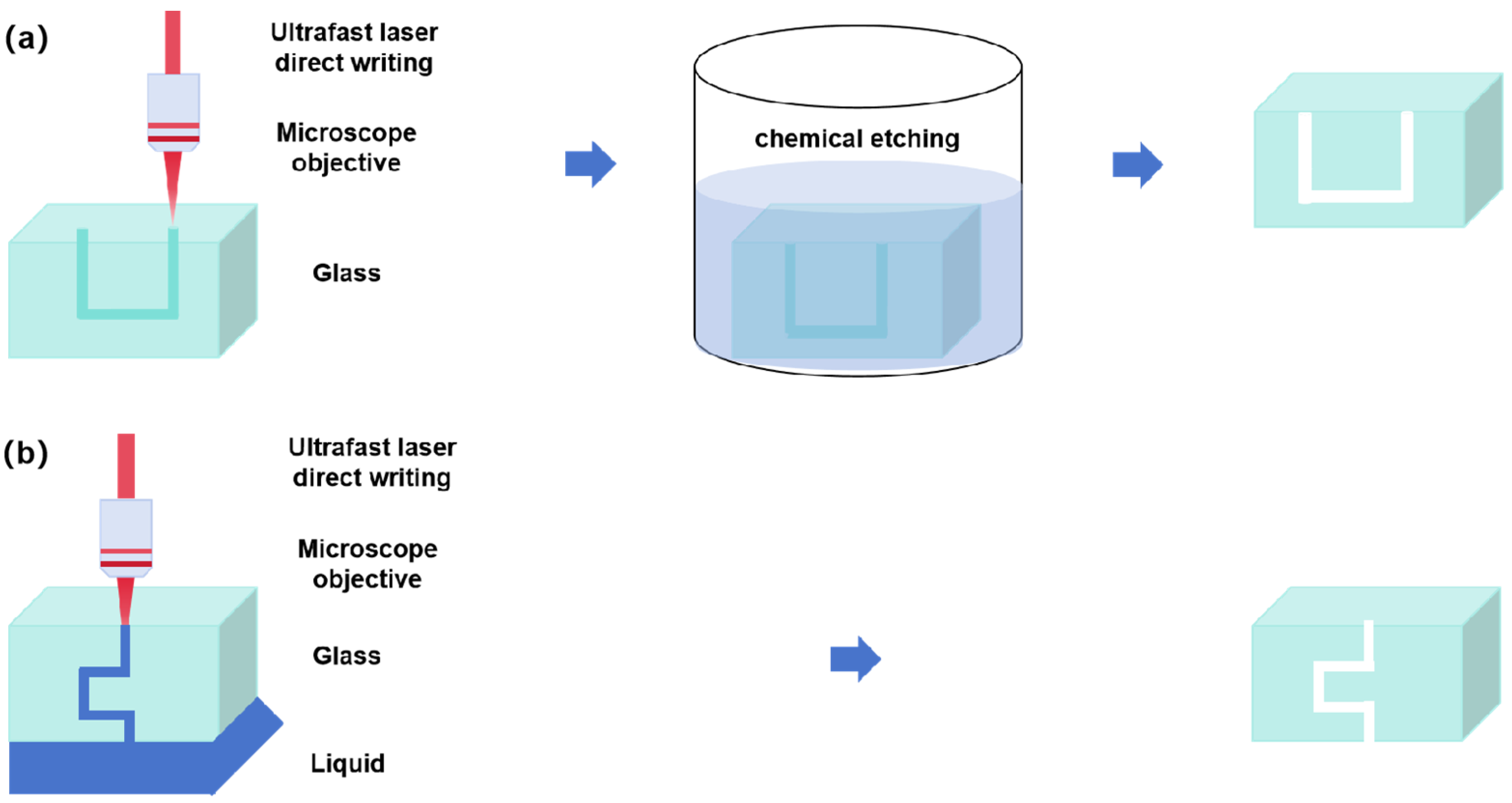

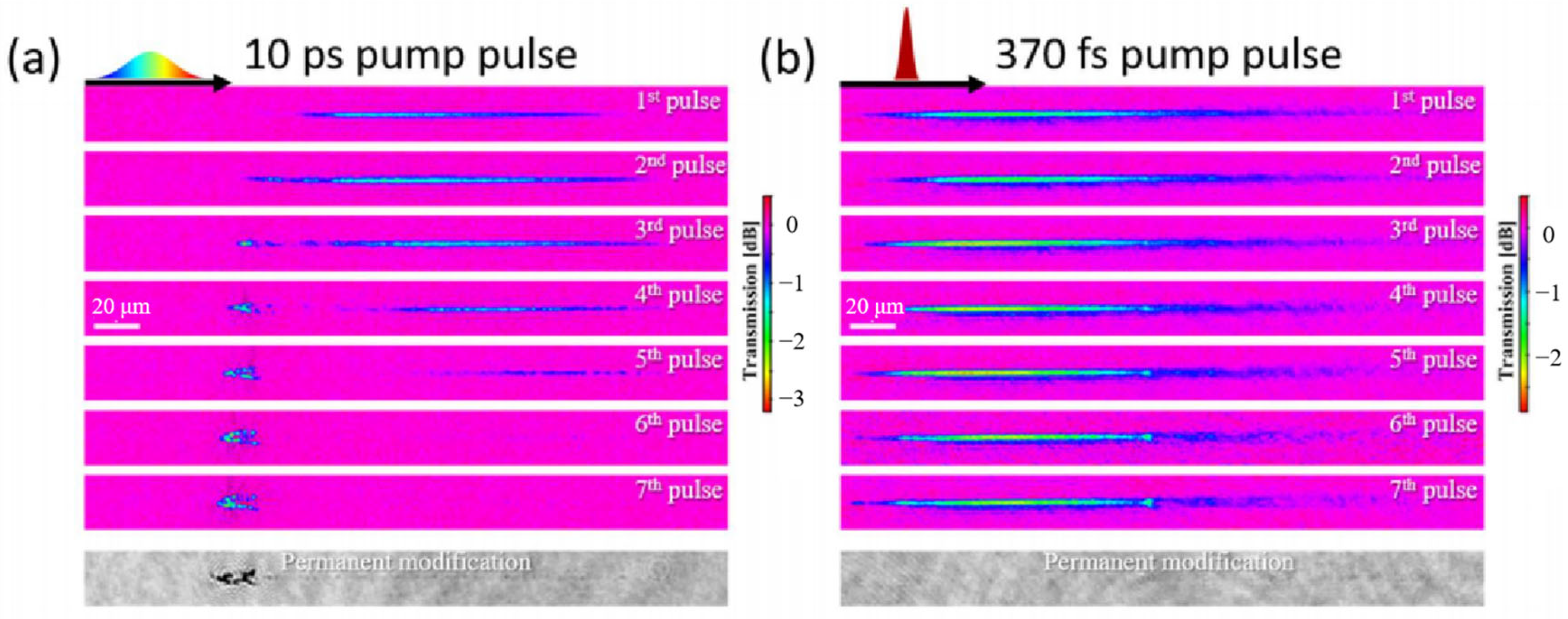
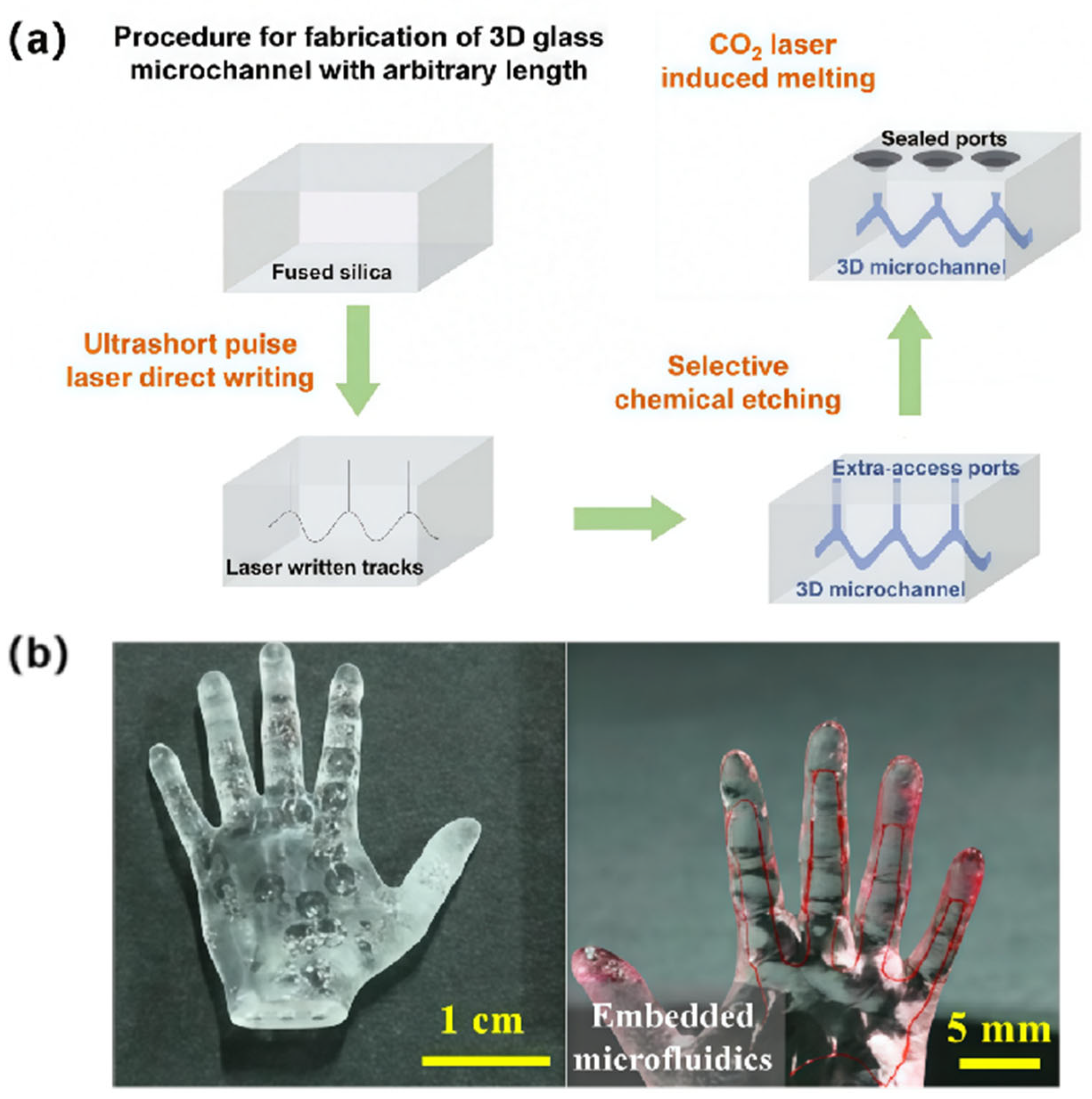
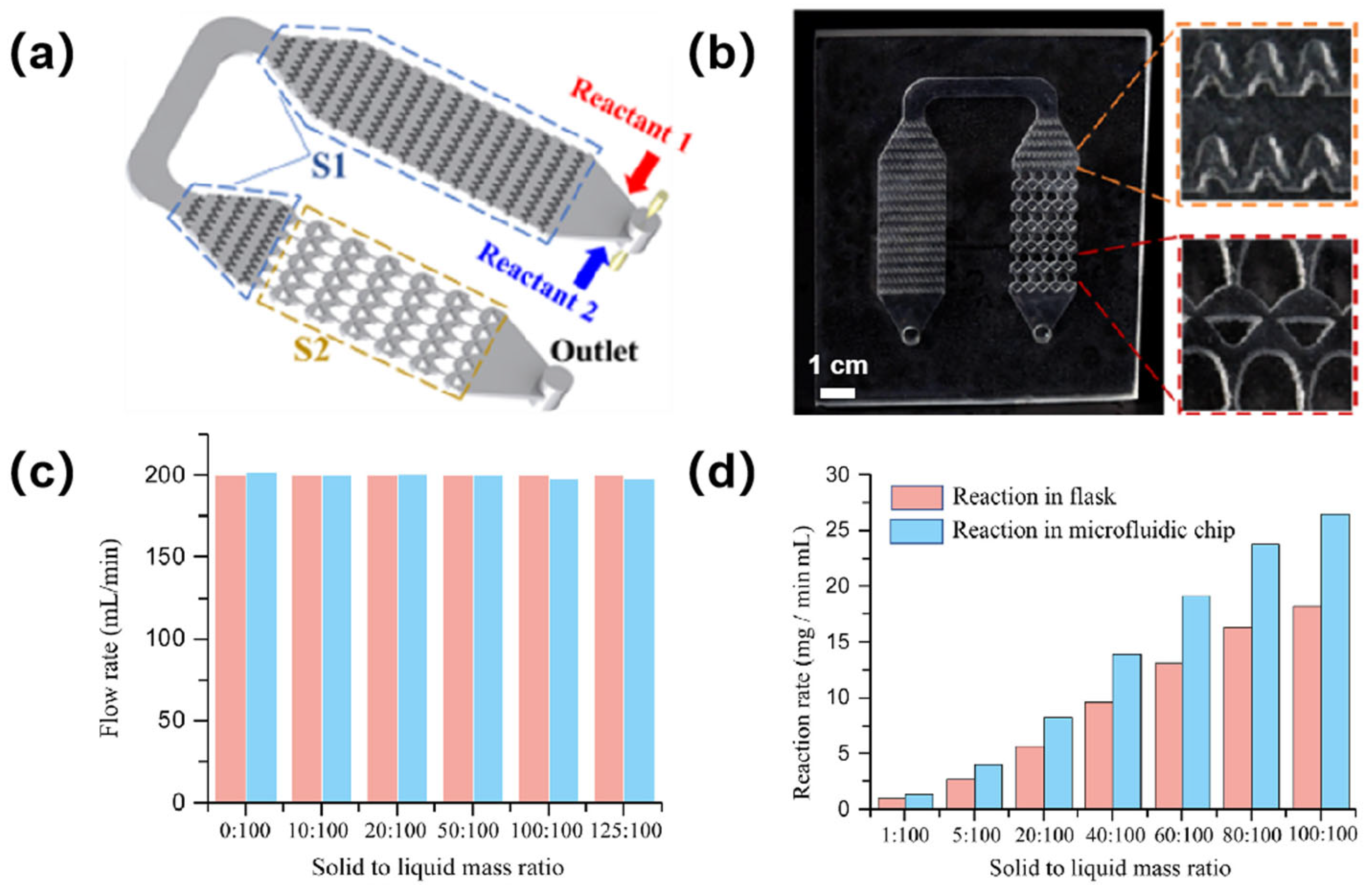

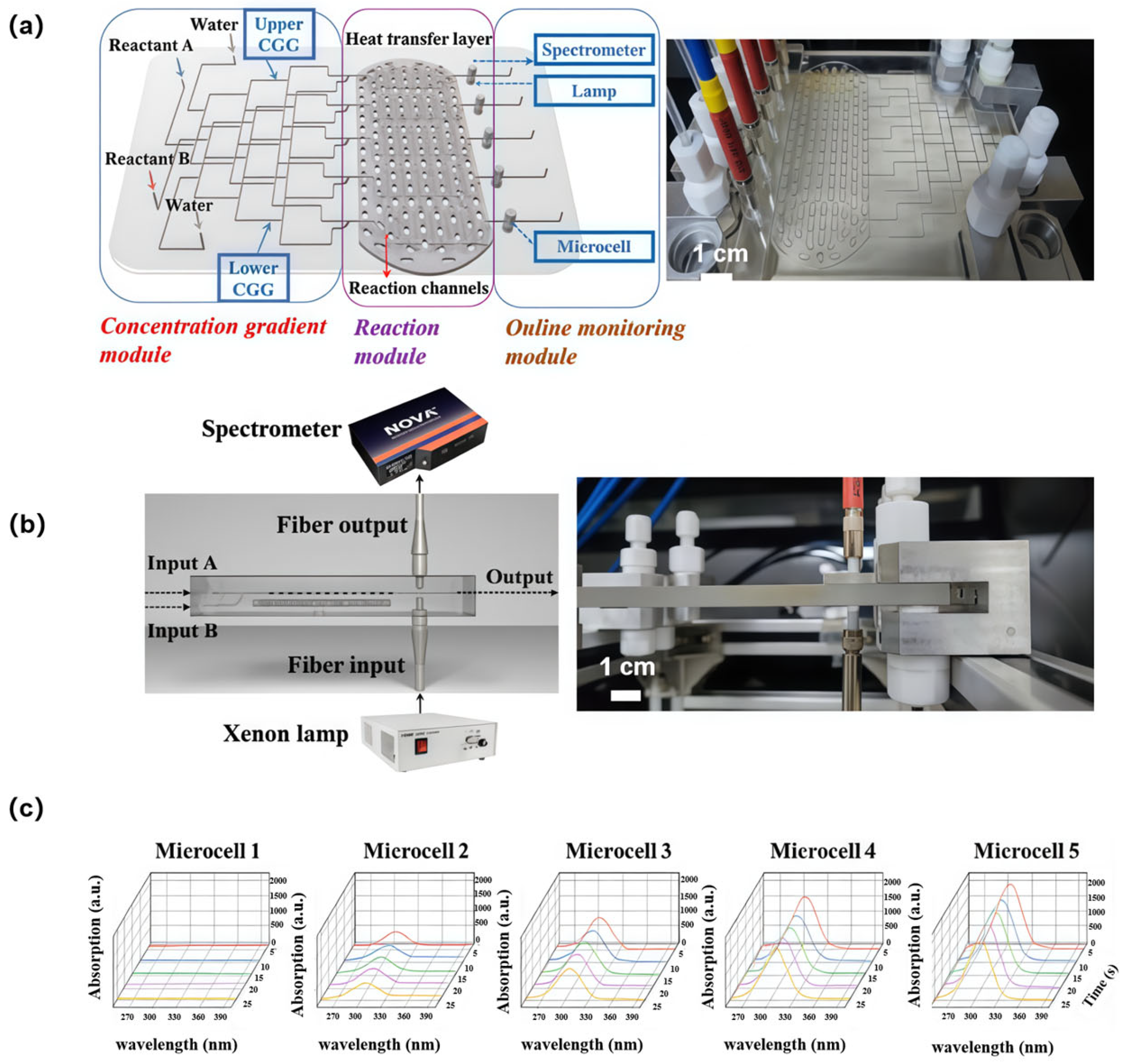


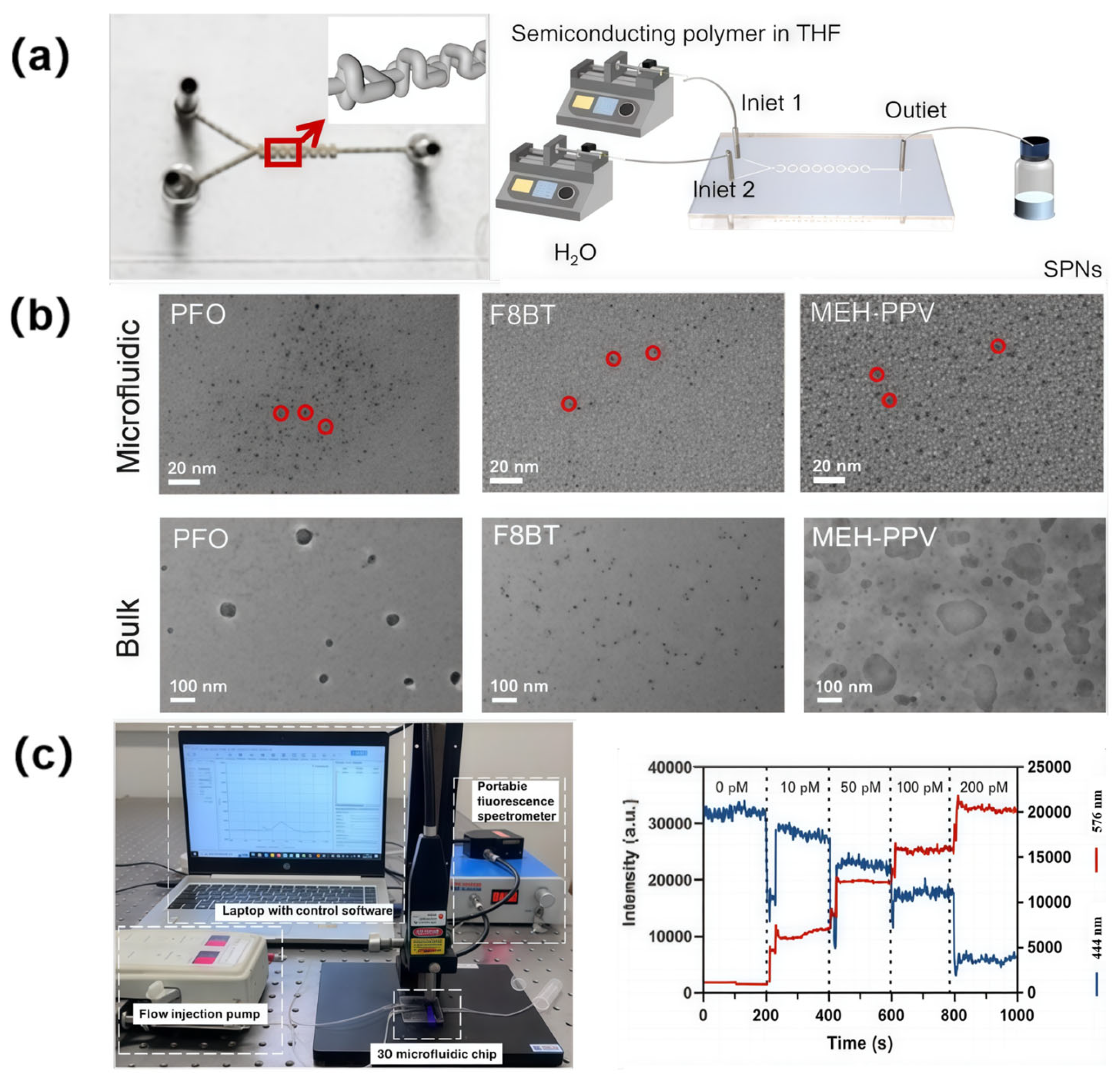
Disclaimer/Publisher’s Note: The statements, opinions and data contained in all publications are solely those of the individual author(s) and contributor(s) and not of MDPI and/or the editor(s). MDPI and/or the editor(s) disclaim responsibility for any injury to people or property resulting from any ideas, methods, instructions or products referred to in the content. |
© 2025 by the authors. Licensee MDPI, Basel, Switzerland. This article is an open access article distributed under the terms and conditions of the Creative Commons Attribution (CC BY) license (https://creativecommons.org/licenses/by/4.0/).
Share and Cite
Li, X.; Huang, J.; Xu, J.; Cheng, Y. Ultrafast Laser-Enabled 3D Glass Microchannel Reactors. Sensors 2025, 25, 7159. https://doi.org/10.3390/s25237159
Li X, Huang J, Xu J, Cheng Y. Ultrafast Laser-Enabled 3D Glass Microchannel Reactors. Sensors. 2025; 25(23):7159. https://doi.org/10.3390/s25237159
Chicago/Turabian StyleLi, Xiaolong, Jinxin Huang, Jian Xu, and Ya Cheng. 2025. "Ultrafast Laser-Enabled 3D Glass Microchannel Reactors" Sensors 25, no. 23: 7159. https://doi.org/10.3390/s25237159
APA StyleLi, X., Huang, J., Xu, J., & Cheng, Y. (2025). Ultrafast Laser-Enabled 3D Glass Microchannel Reactors. Sensors, 25(23), 7159. https://doi.org/10.3390/s25237159








